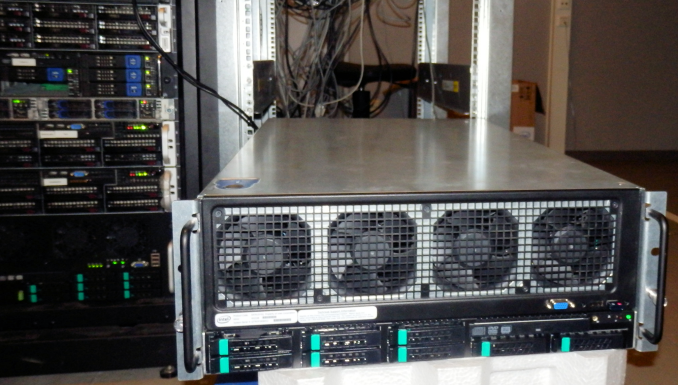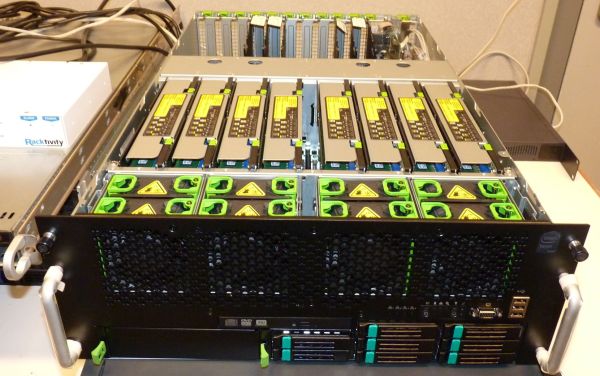The Intel Xeon E7-8800 v3 Review: The POWER8 Killer?
by Johan De Gelas on May 8, 2015 8:00 AM EST- Posted in
- CPUs
- IT Computing
- Intel
- Xeon
- Haswell
- Enterprise
- server
- Enterprise CPUs
- POWER
- POWER8
Benchmark Configuration
As far as reliability is concerned, while we little reason to doubt that the quad Xeon OEM systems out there are the pinnacle of reliability, our initial experience with Xeon E7 v3 has not been as rosy. Our updated and upgraded Quad Xeon Brickland system was only finally stable after many firmware updates, with its issues sorted out just a few hours before the launch of the Xeon E7 v3. Unfortunately this means our time testing the stable Xeon E7 v3 was a bit more limited than we would have liked.
Meanwhile to make the comparison more interesting, we decided to include both the Quad Xeon "Westmere-EX" as well as the "Nehalem-EX". Remember these heavy duty, high RAS servers continue to be used for much longer in the data center than their dual socket counterparts, 5 years or more are no exception. Of course, the comparison would not be complete without the latest dual Xeon 2699 v3 server.
All testing has been done on 64 bit Ubuntu Linux 14.04 (kernel 3.13.0-51, gcc version 4.8.2).
Intel S4TR1SY3Q "Brickland" IVT-EX 4U-server
The latest and greatest from Intel consists of the following components:
| CPU | 4x Xeon E7-8890v3 2.5 GHz 18c, 45 MB L3, 165W TDP or 4x Xeon E7-4890 v2 (D1 stepping) 2.8GHz 15 cores, 37.5MB L3, 155W TDP |
| RAM | 256 GB, 32x 8 GB Micron DDR-4-2100 at 1600MHz or 256 GB, 32x8GB Samsung 8GB DDR3 M393B1K70DH0-YK0 at 1333MHz |
| Motherboard | Intel CRB Baseboard "Thunder Ridge" |
| Chipset | Intel C602J |
| PSU | 2x1200W (2+0) |
Total amount of DIMM slots is 96. When using 64GB LRDIMMs, this server can offer up to 6TB of RAM.
If only two cores are active, the 8890 can boost the clockspeed to 3.3 GHz (AVX code: 3.2 GHz). The 4890v2 reaches 3.4 GHz in that situation. Even with all cores active, 2.9 GHz is possible (AVX code: 2.6 GHz).
Intel Quanta QSCC-4R Benchmark Configuration
The previous quad Xeon E7 server, as reviewed here.
| CPU | 4x Xeon X7560 at 2.26GHz, or 4x Xeon E7-4870 at 2.4GHz |
| RAM | 16x8GB Samsung 8GB DDR3 M393B1K70DH0-YK0 at 1066MHz |
| Motherboard | QCI QSSC-S4R 31S4RMB00B0 |
| Chipset | Intel 7500 |
| BIOS version | QSSC-S4R.QCI.01.00.S012,031420111618 |
| PSU | 4x850W Delta DPS-850FB A S3F E62433-004 850W |
The server can accept up to 64 32GB Load Reduced DIMMs (LR-DIMMs) or 2TB.
Intel's Xeon E5 Server – "Wildcat Pass" (2U Chassis)
Finally, we have our Xeon E5 v3 server:
| CPU | Two Intel Xeon processor E5-2699 v3 (2.3GHz, 18c, 45MB L3, 145W) |
| RAM | 128GB (8x16GB) Samsung M393A2G40DB0 (RDIMM) |
| Internal Disks | 2x Intel MLC SSD710 200GB |
| Motherboard | Intel Server Board Wilcat pass |
| Chipset | Intel Wellsburg B0 |
| BIOS version | August the 9th, 2014 |
| PSU | Delta Electronics 750W DPS-750XB A (80+ Platinum) |
Every server was outfitted with two 200 GB S3700 SSDs.












146 Comments
View All Comments
Brutalizer - Tuesday, May 12, 2015 - link
Again, Hana is a clustered RAM database. And as I have shown above with the Oracle TenTimes RAM database, these are totally different from a normal database. In Memory DataBases can never replace a normal database, as IMDB are optimized for reading data (analysis), not modifying data.Regarding SGI UV300H, it is a 16 socket server, i.e. scale-up server. It is not a huge scale-out cluster. And therefore UV300H might be good for business software, but I dont know the performance of SGI's first(?) scale-up server. Anyway, 16 socket servers are different from SGI UV2000 scale out clusters. And UV2000 can not be used for business software. As evidenced by non existing SAP benchmarks.
ats - Wednesday, May 13, 2015 - link
No, you haven't shown anything. You quote some random whitepaper on the internet like it is gospel and ignore the fact that in memory dbs are used daily as the primary in OLTP, OLAP, BI, etc workloads.And you don't understand that a significant number of the IMDBs are actually designed directly for the OLTP market which is precisely the DB workload that is modifying the most data and is the most complex and demanding with regard to locks and updates.
There is no architecural difference between the UV300 and the UV2k except slightly faster interconnect. And just an fyi, UV300 is like SGI's 30th scale up server. After all, they've been making scale up server for longer than Sun/Oracle.
questionlp - Monday, May 11, 2015 - link
HP Superdome X is a 16-socket x86 server that will probably end up replacing the Itanium-based Superdome if HP can scale the S/X to 32 sockets.Brutalizer - Monday, May 11, 2015 - link
HP will face great difficulties if they try to mod and go beyond 8 sockets on the old Superdome. Heck, even 8 sockets have scaling difficulties on x86.Kevin G - Monday, May 11, 2015 - link
Except that you can you buy a 16 socket Superdome X *today*.http://h20195.www2.hp.com/V2/getpdf.aspx/4AA5-6149...
The interconnect they're using for the Superdome X is from the old Poulson Itaniums that use QPI which can scale to 64 sockets.
rbanffy - Wednesday, May 13, 2015 - link
You talk "serious business workloads". Of course, there are organizations that use technology that does not scale horizontally, where adding more machines to share the workload does not work because the workload was not designed to be shared. For those, there are solutions that offer progressively less performance per dollar for levels of single-box performance that are unattainable on high-end x86 machines, but that is just because those organizations are limited by the technology they chose.There is nothing in SAP (except its design) or (non-rel) databases that preclude horizontal scaling. It's just that the software was designed in an age when horizontal scaling was not in fashion (even though VAXes have been doing clustering since I was a young boy) and now it's too late to rebuild it from scratch.
mapesdhs - Friday, May 8, 2015 - link
Good point, I wonder why they've left it at only 2/core for so long...name99 - Friday, May 8, 2015 - link
It's not easy to ramp up the number of threads. In particular POWER8 uses something I've never seen any other CPU do --- they have a second tier register file (basically an L2 for registers) and the system dynamically moves data between the two register files as appropriate.It's also much easier for POWER8 to decode 8 instructions per cycle (and to do the multiple branch prediction per cycle to make that happen). Intel could maybe do that if they reverted to a trace cache, but the target codes for this type of CPU are characterized by very large I-footprints and not much tight looping, so trace caches, loop caches, micro-op caches are not that much help. Intel might have to do something like a dual-ported I-cache, and running two fetch streams into two independent sets of 4-wide decoders.
xdrol - Saturday, May 9, 2015 - link
Another register file is just a drop in the ocean. The real problem is the increasing L1/2/.. cache pressure; what can only be mitigated by increasing cache size; what in turn will make your cache access slower, even when you use only one of the SMT threads.Also, you need to have enough unused execution capacity (pipeline ports) for another hardware thread to be useful; the 2 threads in Haswell can already saturate the 7 execution ports with quite high probability, so the extra thread can only run in expense of the other, and due to the cache effects, it's probably faster to just get the 2 tasks executed sequentially (within the same thread). This question could be revisited if the processor has 14 execution port, 2x issue, 2x cache, 2x everything, so it can have 4T/1C, but then it's not really different from 2 normal size cores with 4T..
iAPX - Friday, May 8, 2015 - link
It's because this is the same architecture (mainly) that is used on desktop, laptops, and now even mobility!With this market share, I won't be surprised that Intel decided to create a new architecture (x86-64 based) for future server chips, much more specialized, dropping AVX for cloud servers, having 4+ threads per core with simpler decoder and a lot of integer and load/store units!
That might be complemented by a Xeon Phi socketable for floating-point compute intensive tasks and workstations, but it's unclear even if Intel announced it far far ago! ;)